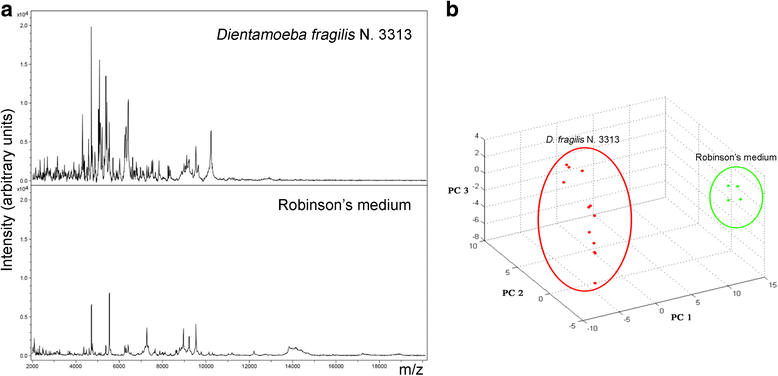MALDI-TOF MS as a new tool for the identification of Dientamoeba fragilis
- PMID: 29301570
- PMCID: PMC5755284
- DOI: 10.1186/s13071-017-2597-3
MALDI-TOF MS as a new tool for the identification of Dientamoeba fragilis
Abstract
Background: In this study for the first time, a Dientamoeba fragilis protein profile by MALDI-TOF MS was created in order to identify specific markers for the application of this technology in the laboratory diagnosis of dientamoebiasis. In particular, one D. fragilis reference strain was used to create a reference spectrum and 14 clinical isolates to verify the reliability of the obtained results.
Results: While 15 peaks were found to be discriminating between the reference strain and the culture medium used, six peaks, observed in all the 14 strains tested, were considered as markers able to identify D. fragilis.
Conclusions: In our hands, MALDI-TOF MS technology was demonstrated as a useful tool to be used in association with or in replacement of the real-time PCR assay for the identification of D. fragilis used in our laboratory on xenic cultures, due to its accuracy, rapidity and low cost.
Keywords: Dientamoeba fragilis; Identification; MALDI-TOF mass spectrometry.
Conflict of interest statement
Ethics approval and consent to participate
The samples analyzed in this and previous studies were obtained by the University Hospital of Parma for routine diagnosis purposes. No approval by the Institutional Review Board was required because the laboratory diagnosis results had been reported in the medical records of the patients as a diagnostic answer to a clinical suspicion of intestinal parasitosis. Ethical approval at the University Hospital of Parma is required only in cases where the clinical samples are to be used for applications other than diagnosis.
Consent for publication
Not applicable.
Competing interests
The authors declare that they have no competing interests.
Publisher’s Note
Springer Nature remains neutral with regard to jurisdictional claims in published maps and institutional affiliations.
Figures




References
Publication types
MeSH terms
Substances
Grants and funding
- FIL/Ministero dell'Istruzione, dell'Università e della Ricerca/International
- The Biobank of microorganisms and viruses pathogenic to humans as a starting point for the study of the infectious diseases and zoonoses/Bureau of the Council of Ministers - Italian National Committee for Biosafety, Biotechnology and Life Sciences/International
LinkOut - more resources
Full Text Sources
Other Literature Sources

